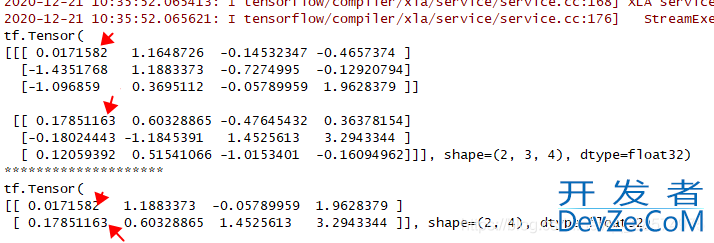解读MaxPooling1D和GlobalMaxPooling1D的区别
目录
- MaxPooling1D和GlobalMaxPooling1D区别
- 输出如下图
- tf.keras.layers.GlobalMaxPool1D()
- 总结
MaxPooling1D和GlobalMaxPooling1D区别
import tensorflow as tf
from tensorflow impopythonrt keras
input_shape = (2, 3, 4)
x = tf.random.normal(input_shape)
print(x)
y=keras.layers.GlobalMaxPool1D()(x)
print("*"*20)
print(y)
'''
"""Global average pooling operation for temporal data.
Examples:
>>> input_shape = (2, 3, 4)
>>> x = tf.random.normal(input_shape)
>>> y = tf.keras.layers.GlobalAveragePooling1D()(x)
>>> print(y.shape)
(2, 4)
Arguments:
data_format: A string,
one of `channels_last` (default) or `channels_first`.
The ordering of the dimensions in the inputs.
`channels_last` corresponds to inputs with shape
`(BATch, steps, features)` while `channels_first`
corresp开发者_Go开发onds to inputs with shape
`(batch, features, steps)`.
Call arguments:
inputs: A 3D tensor.
mask: Binary tensor of shape `(batch_size, steps)` indicating whether
a given step should be masked (excluded from the average).
Input shape:
- If `data_format='channels_last'`:
3D tensor with shape:
`(batch_size, steps, features)`
- If `data_format='channels_first'`:
3D tensor with shape:
`(batch_size, features, steps)`
Output shape:
2D tensor with shape `(batch_size, features)`.
"""
'''
print("--"*20)
input_shape = (2, 3, 4)
x = tf.random.normal(input_shape)
print(x)
y=www.devze.comkeras.layers.MaxPool1D(pool_size=2,strides=1)(x) # strides 不指定 默认等于 pool_size
print("*"*20)
print(y)
输出如下图
上图GlobalMaxPool1D 相当于给每一个样本每列的最大值

而MaxPool1D就是普通的对每一个样本进行一个窗口(1D是一维列窗口)滑动取最大值。
tf.keras.layers.GlobalMaxPool1D()
与tf.keras.layers.Conv1D的输入一样,输入一个三维数据(batch_size,feature_size,output_dimension)
x = tf.编程客栈constant([[1., 2., 3.], [4., 5., 6.]]) phpx = tf.reandroidshape(x, [2, 3, 1]) max_pool_1d=tf.keras.layers.GlobalMaxPooling1D() max_pool_1d(x)
其中max_pool_1d(x)和tf.math.reduce_max(x,axis=-2,keepdims=False)作用相同
总结
以上为个人经验,希望能给大家一个参考,也希望大家多多支持我们。







 加载中,请稍侯......
加载中,请稍侯......
精彩评论